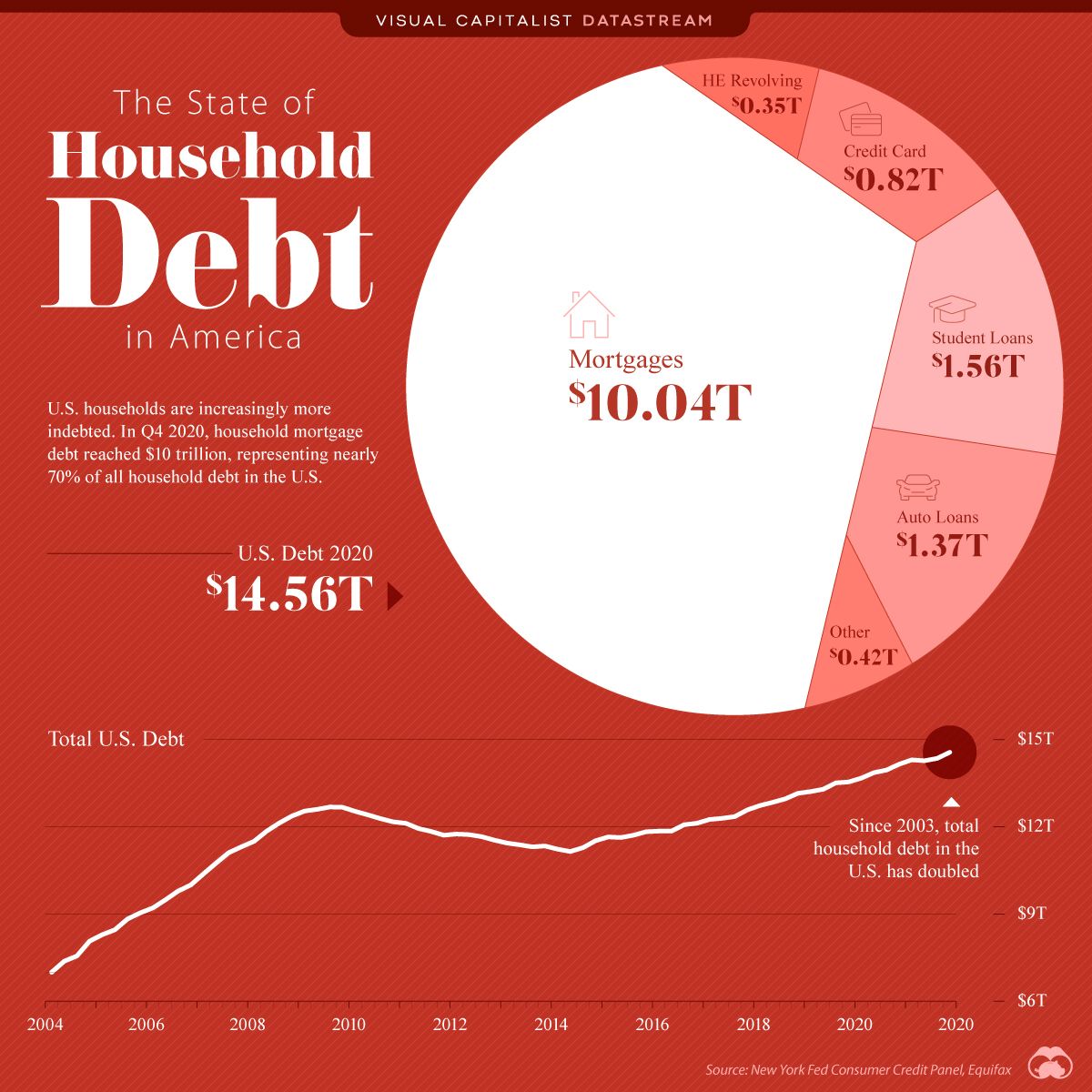Datastream
The State of Household Debt in America

The Briefing
- U.S. household debt stands at $14.56 trillion, and has doubled since 2003
- Student loan debt has expanded a colossal 550% in the same time frame
The State of Household Debt in America
American households are becoming increasingly indebted.
In 2003, total household debt was $7.23 trillion, but that figure has recently doubled to $14.56 trillion in 2020. With just under 130 million households in the country, this equates to an average of $118,000 of debt per household.
Here’s how the various forms of U.S. household debt compare.
| Type of Debt | 2003 (in trillions) | 2020 (in trillions) | % Growth |
|---|---|---|---|
| Mortgage | $4.94 | $10.04 | +103% |
| Home Equity Revolving | $0.24 | $0.35 | +45% |
| Auto Loan | $0.64 | $1.37 | +137% |
| Credit Card | $0.69 | $0.82 | +18% |
| Student Loan | $0.24 | $1.56 | +550% |
| Other | $0.48 | $0.42 | -12% |
| Total | $7.23 | $14.46 | 100% |
Mortgages: Steep Price to Pay for Home Ownership
Making up roughly 70% of all household debt, and growing $5.1 trillion since 2003, mortgage debt now stands at $10.04 trillion.
A fundamental driver of mortgage activity is interest rates. Given the two variables tend to have an inverse relationship with one another, interest rates have a big impact on the affordability of housing. As long as U.S. interest rates remain near 200-year lows, its likely mortgages will maintain at elevated levels.
Students Continue Struggling with Student Debt
The second-largest form of debt is student loans. Although not quite the size of mortgages in raw dollars, student debt is the fastest growing as a percentage, having shot up 550% from 2003 to 2020.
The topic of debt is highly discussed in today’s political and economic climate. That’s largely because debt has risen on all fronts to unprecedented levels. For example, the U.S. national debt has recently passed $27 trillion while corporate debt stands at $10.5 trillion.
Throw the aforementioned household debt into the mix and you have a $52 trillion debt pile. That’s a big bill to pay.
Where does this data come from?
Source: Federal Reserve Bank of New York
Notes: Data ranges from Q1 2004 to Q4 2020
Datastream
Can You Calculate Your Daily Carbon Footprint?
Discover how the average person’s carbon footprint impacts the environment and learn how carbon credits can offset your carbon footprint.

The Briefing
- A person’s carbon footprint is substantial, with activities such as food consumption creating as much as 4,500 g of CO₂ emissions daily.
- By purchasing carbon credits from Carbon Streaming Corporation, you can offset your own emissions and fund positive climate action.
Your Everyday Carbon Footprint
While many large businesses and countries have committed to net-zero goals, it is essential to acknowledge that your everyday activities also contribute to global emissions.
In this graphic, sponsored by Carbon Streaming Corporation, we will explore how the choices we make and the products we use have a profound impact on our carbon footprint.
Carbon Emissions by Activity
Here are some of the daily activities and products of the average person and their carbon footprint, according to Clever Carbon.
| Household Activities & Products | CO2 Emissions (g) |
|---|---|
| 💡 Standard Light Bulb (100 watts, four hours) | 172 g |
| 📱 Mobile Phone Use (195 minutes per day)* | 189 g |
| 👕 Washing Machine (0.63 kWh) | 275 g |
| 🔥 Electric Oven (1.56 kWh) | 675 g |
| ♨️ Tumble Dryer (2.5 kWh) | 1,000 g |
| 🧻 Toilet Roll (2 ply) | 1,300 g |
| 🚿 Hot Shower (10 mins) | 2,000 g |
| 🚙 Daily Commute (one hour, by car) | 3,360 g |
| 🍽️ Average Daily Food Consumption (three meals of 600 calories) | 4,500 g |
| *Phone use based on yearly use of 69kg per the source, Reboxed | |
Your choice of transportation plays a crucial role in determining your carbon footprint. For instance, a 15 km daily commute to work on public transport generates an average of 1,464 g of CO₂ emissions. Compared to 3,360 g—twice the volume for a journey the same length by car.
By opting for more sustainable modes of transport, such as cycling, walking, or public transportation, you can significantly reduce your carbon footprint.
Addressing Your Carbon Footprint
One way to compensate for your emissions is by purchasing high-quality carbon credits.
Carbon credits are used to help fund projects that avoid, reduce or remove CO₂ emissions. This includes nature-based solutions such as reforestation and improved forest management, or technology-based solutions such as the production of biochar and carbon capture and storage (CCS).
While carbon credits offer a potential solution for individuals to help reduce global emissions, public awareness remains a significant challenge. A BCG-Patch survey revealed that only 34% of U.S. consumers are familiar with carbon credits, and only 3% have purchased them in the past.
About Carbon Streaming
By financing the creation or expansion of carbon projects, Carbon Streaming Corporation secures the rights to future carbon credits generated by these sustainable projects. You can then purchase these carbon credits to help fund climate solutions around the world and compensate for your own emissions.
Ready to get involved?
>> Learn more about purchasing carbon credits at Carbon Streaming
-

 Debt1 week ago
Debt1 week agoHow Debt-to-GDP Ratios Have Changed Since 2000
-

 Markets2 weeks ago
Markets2 weeks agoRanked: The World’s Top Flight Routes, by Revenue
-

 Demographics2 weeks ago
Demographics2 weeks agoPopulation Projections: The World’s 6 Largest Countries in 2075
-

 Markets2 weeks ago
Markets2 weeks agoThe Top 10 States by Real GDP Growth in 2023
-

 Demographics2 weeks ago
Demographics2 weeks agoThe Smallest Gender Wage Gaps in OECD Countries
-

 United States2 weeks ago
United States2 weeks agoWhere U.S. Inflation Hit the Hardest in March 2024
-

 Green2 weeks ago
Green2 weeks agoTop Countries By Forest Growth Since 2001
-

 United States2 weeks ago
United States2 weeks agoRanked: The Largest U.S. Corporations by Number of Employees














